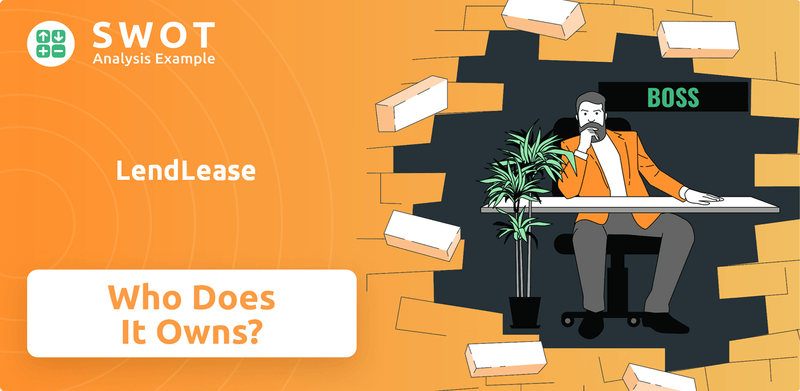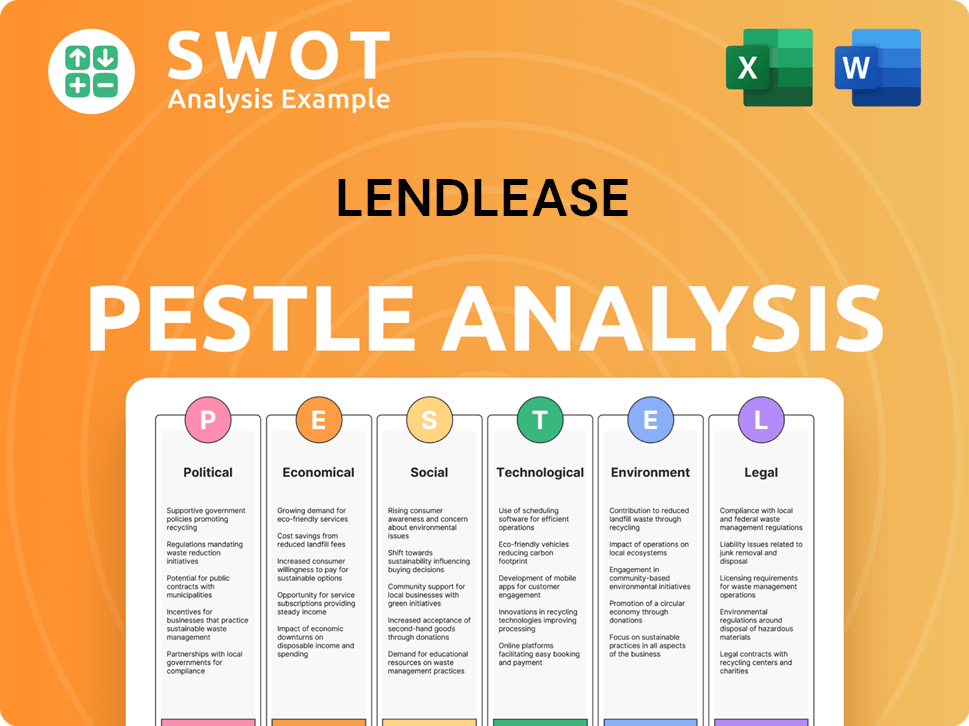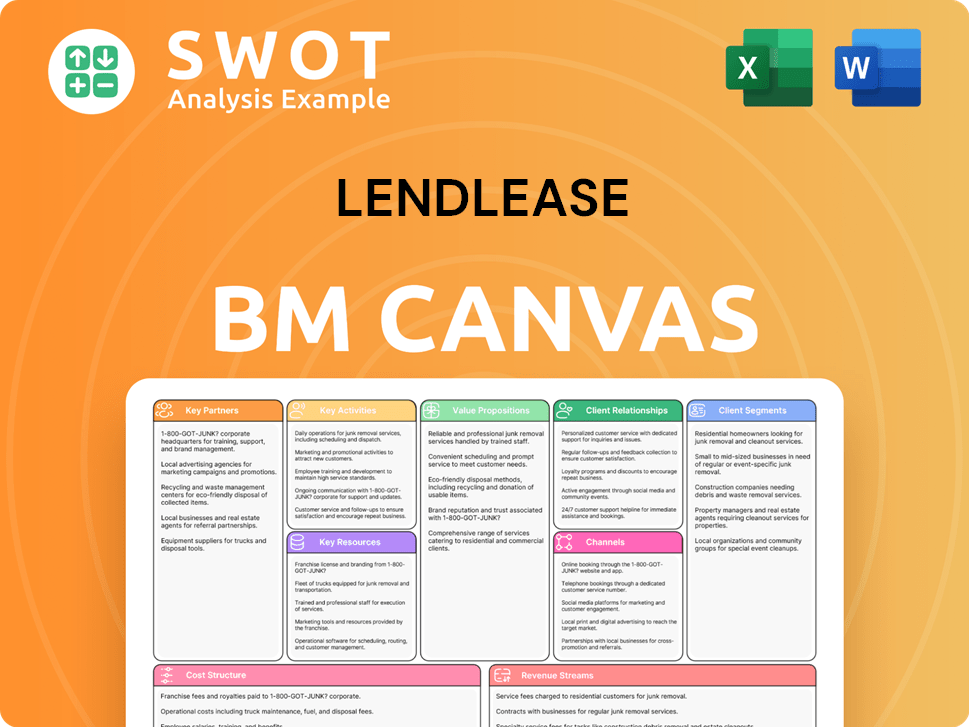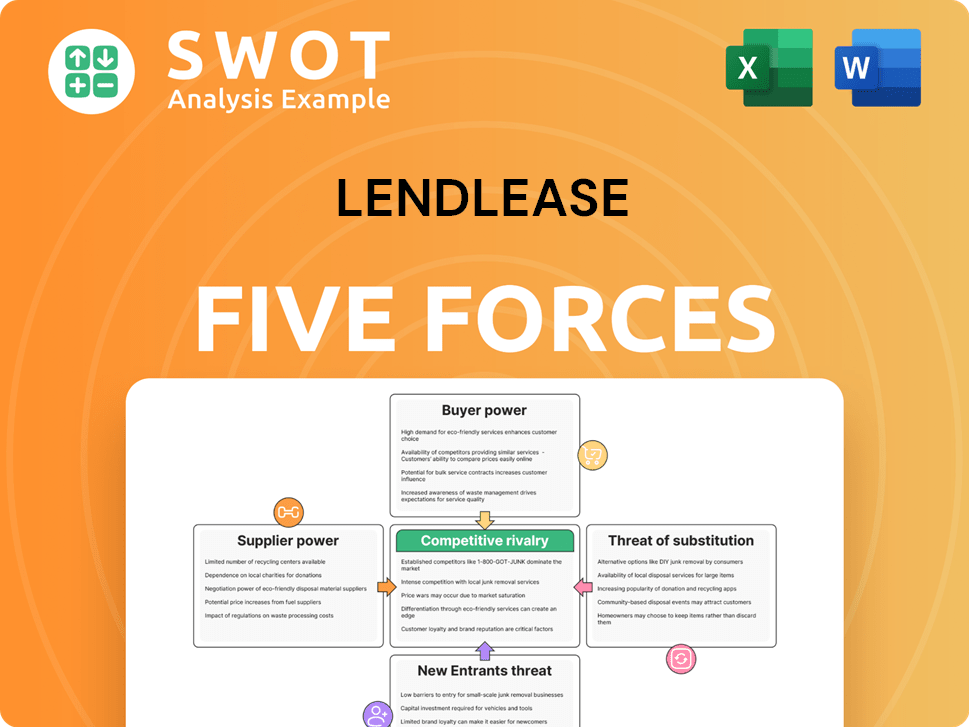LendLease Bundle
Who Really Controls Lendlease?
Unraveling the Lendlease SWOT Analysis is just the beginning; understanding its ownership is key to predicting the company's future. With a significant strategic shift underway, focusing on its Australian operations, the Lendlease company is at a pivotal juncture. This deep dive explores the Lendlease ownership structure and its implications.

From its origins in 1958 to its current status as a global player, the Lendlease company's journey has been shaped by its ownership dynamics. Understanding the Lendlease shareholders and their influence is critical, especially given recent changes driven by market pressures and strategic realignments. This article will examine the Lendlease history to provide a comprehensive view of the company's evolution and the role of its Lendlease executives.
Who Founded LendLease?
The genesis of the company can be traced back to 1958 when Dick Dusseldorp, a Dutch immigrant, established it with an initial capital of £10,000 and a team of 35 tradesmen. Initially conceived as a finance and investment firm, the company was designed to support the construction projects of Civil & Civic, which it later acquired in 1961. This marked the beginning of what would become a global property and infrastructure giant.
At its inception, the company was listed on the Australian stock exchange. Civil & Civic held a substantial 40% shareholding, reflecting Dusseldorp's vision of integrating finance, construction, development, and investment. This early structure set the stage for the company's integrated approach to property development and investment.
Dusseldorp's focus on earnings and cash flow, rather than solely asset ownership, proved successful, especially during challenging periods in the property market. This approach helped the company navigate the complexities of the real estate industry. The early financing of Civil & Civic's construction projects demonstrated a tightly integrated operational and financial model.
Founded in 1958 by Dick Dusseldorp.
Started with £10,000.
Listed on the Australian stock exchange.
Acquired Civil & Civic in 1961.
Civil & Civic held a 40% shareholding.
Emphasis on earnings and cash flow.
The initial public listing and Civil & Civic's significant stake indicated a blend of public and corporate ownership from the outset. The company's early focus on earnings and cash flow, rather than solely asset ownership, proved successful. The company's early structure laid the foundation for its future growth and integrated approach to property development. Understanding the Lendlease ownership structure from its inception helps in appreciating its evolution. The company's history is a blend of strategic financial decisions. Learn more about the Target Market of LendLease.
- Initial public offering on the Australian stock exchange.
- Civil & Civic's 40% shareholding.
- Emphasis on earnings and cash flow.
- Integrated operational and financial model.
LendLease SWOT Analysis
- Complete SWOT Breakdown
- Fully Customizable
- Editable in Excel & Word
- Professional Formatting
- Investor-Ready Format

How Has LendLease’s Ownership Changed Over Time?
The evolution of Lendlease's ownership structure has been marked by strategic shifts since its listing on the Australian Securities Exchange (ASX) in 1962. A pivotal move occurred in 1982 with the acquisition of a 50% interest in MLC, followed by the complete acquisition in 1985. This expansion into insurance and financial services, including the introduction of MLC's multi-manager investment philosophy in 1986, significantly diversified the company. However, a major change came in 2000 when MLC was sold to National Australia Bank for $4.56 billion, reshaping the company's focus.
In recent years, Lendlease has seen its major shareholding influenced by institutional investors, mutual funds, and activist investors. As a public company, shares are traded under the ticker LLC. The company’s ownership structure is dynamic, reflecting the influence of market forces and strategic decisions. For example, the company's strategic direction has been impacted by activist investors who have pushed for changes in the company's strategy and governance.
| Event | Year | Impact on Ownership |
|---|---|---|
| Initial Public Offering (IPO) | 1962 | Listed on the Australian Securities Exchange (ASX). |
| Acquisition of MLC (50% stake) | 1982 | Diversified into insurance and financial services. |
| Full Acquisition of MLC | 1985 | Made MLC a wholly-owned subsidiary. |
| Sale of MLC to National Australia Bank | 2000 | Significant shift in business focus. |
As of June 13, 2025, Lendlease's market capitalization is approximately AUD $2.52 billion, with 690 million shares outstanding. The 2024 Annual Report, released on August 19, 2024, provides detailed financial information. Several activist investors, including HMC Capital Partners, Allan Gray, Tanarra Capital, and Aware Super, have been actively involved, advocating for changes. Tanarra Capital's pressure led to a strategic refresh announced in May 2024, influencing the company's direction, including a refocus on Australian operations and a potential exit from international property development. To learn more about how Lendlease is navigating the market, you can read this article on Growth Strategy of LendLease.
Lendlease's ownership has evolved significantly since its IPO in 1962, with major shifts influenced by acquisitions, divestments, and activist investors.
- The company's strategic direction has been impacted by institutional investors and activist shareholders.
- Market capitalization as of June 13, 2025, is approximately AUD $2.52 billion.
- The 2024 Annual Report provides detailed financial disclosures.
- Activist investor pressure has led to strategic changes, including a refocus on Australian operations.
LendLease PESTLE Analysis
- Covers All 6 PESTLE Categories
- No Research Needed – Save Hours of Work
- Built by Experts, Trusted by Consultants
- Instant Download, Ready to Use
- 100% Editable, Fully Customizable

Who Sits on LendLease’s Board?
The current Board of Directors of the Lendlease Group significantly influences the company's governance and strategic direction. According to the 2024 Consolidated Financial Report for Lendlease Trust, the directors of Lendlease Responsible Entity Limited, a wholly-owned subsidiary of Lendlease Corporation Limited, include M J Ullmer, who has served as Chairman since 2018, and A P Lombardo, who holds the positions of Group Chief Executive Officer since June 2021 and Managing Director since September 2021. Other board members include A S Chan (M Lui), P M Coffey, N R Collishaw, D P Craig, and B A Knoflach, who was appointed on October 1, 2023.
The composition of the board and its leadership structure are crucial for understanding how the company is managed and the direction it is taking. The board's decisions impact Lendlease's strategic initiatives, financial performance, and overall corporate strategy. Understanding the roles and tenures of the directors provides insight into the stability and evolution of the company's leadership.
| Director | Position | Appointment Date |
|---|---|---|
| M J Ullmer | Chairman | 2018 |
| A P Lombardo | Group Chief Executive Officer & Managing Director | June 2021 & September 2021 |
| A S Chan (M Lui) | Director | N/A |
| P M Coffey | Director | N/A |
| N R Collishaw | Director | N/A |
| D P Craig | Director | N/A |
| B A Knoflach | Director | October 1, 2023 |
Lendlease's shares are traded on the Australian Securities Exchange (ASX) as a single security, combining shares in Lendlease Corporation and units in Lendlease Trust. This typically implies a one-share-one-vote structure for public shareholders. However, specific details on dual-class shares or special voting rights are not explicitly detailed in publicly available summaries. The influence of major shareholders is often exerted through their representation or advocacy to the board, as seen with activist investor campaigns. The company's ownership structure and how shares are voted are critical aspects of how the company is controlled and how decisions are made.
Recent proxy battles and activist investor campaigns have significantly impacted decision-making within Lendlease. Firms like Tanarra Capital, Allan Gray, and HMC Capital have actively pushed for board renewal and strategic changes. These campaigns, especially in 2024, have led to Lendlease conceding to investor demands and announcing a major strategic overhaul, including the divestment of overseas operations. This demonstrates the substantial influence that a collective of significant shareholders can wield in shaping the company's future.
- Activist investors have pushed for significant changes.
- The company has responded with a strategic overhaul.
- Overseas operations are being divested.
- This reflects the power of major shareholders.
LendLease Business Model Canvas
- Complete 9-Block Business Model Canvas
- Effortlessly Communicate Your Business Strategy
- Investor-Ready BMC Format
- 100% Editable and Customizable
- Clear and Structured Layout

What Recent Changes Have Shaped LendLease’s Ownership Landscape?
Over the past few years, the ownership profile of the Lendlease company has seen significant shifts. These changes reflect a broader strategy focused on simplification and enhancing returns for Lendlease shareholders. The company's recent moves, particularly its strategic refresh announced in May 2024, underscore a shift towards a more streamlined operational model. This includes divesting overseas development and construction businesses to concentrate on the Australian market.
This restructuring aims to free up approximately AUD 4.5 billion in capital. The plan involves selling assets, including the UK construction business to Atlas Holdings, which was substantially completed by early 2025, and the US construction operations. Additionally, the company intends to exit its US military housing business by early 2025. These divestments are crucial for debt reduction and potentially for securities buybacks, aligning with the company's financial strategy. The company's focus is now on its core Australian operations and its international Investments platform.
| Metric | As of June 2024 | Target |
|---|---|---|
| Net Debt | AUD 3.2 billion | |
| Gearing | 27% (as of February 2025) | 5-15% by the end of FY26 |
| Asset Sales Targeted for FY25 | AUD 2.8 billion |
The changes in Lendlease ownership are also influenced by industry trends, such as increased institutional ownership. Activist investors like Tanarra Capital, Allan Gray, and HMC Capital have played a role in driving these strategic shifts, advocating for board renewal and a focus on domestic operations. The Group CEO, Tony Lombardo, has emphasized strengthening the balance sheet, returning capital to securityholders, and redeploying capital to grow future earnings. This strategic pivot is expected to shift the company's earnings mix, with investments projected to contribute around 50% of group midcycle EBITDA. For a deeper understanding of the company's operations, consider reading about Revenue Streams & Business Model of LendLease.
The company is concentrating its efforts on the Australian market. This strategic shift aims to leverage its strengths in the domestic market.
A key priority is reducing debt through asset sales. This will improve financial stability and flexibility.
The company is focused on increasing shareholder value. This includes returning capital and growing earnings.
Activist investors are actively pushing for strategic changes. This is a trend in the company's recent history.
LendLease Porter's Five Forces Analysis
- Covers All 5 Competitive Forces in Detail
- Structured for Consultants, Students, and Founders
- 100% Editable in Microsoft Word & Excel
- Instant Digital Download – Use Immediately
- Compatible with Mac & PC – Fully Unlocked

Related Blogs
- What are Mission Vision & Core Values of LendLease Company?
- What is Competitive Landscape of LendLease Company?
- What is Growth Strategy and Future Prospects of LendLease Company?
- How Does LendLease Company Work?
- What is Sales and Marketing Strategy of LendLease Company?
- What is Brief History of LendLease Company?
- What is Customer Demographics and Target Market of LendLease Company?
Disclaimer
All information, articles, and product details provided on this website are for general informational and educational purposes only. We do not claim any ownership over, nor do we intend to infringe upon, any trademarks, copyrights, logos, brand names, or other intellectual property mentioned or depicted on this site. Such intellectual property remains the property of its respective owners, and any references here are made solely for identification or informational purposes, without implying any affiliation, endorsement, or partnership.
We make no representations or warranties, express or implied, regarding the accuracy, completeness, or suitability of any content or products presented. Nothing on this website should be construed as legal, tax, investment, financial, medical, or other professional advice. In addition, no part of this site—including articles or product references—constitutes a solicitation, recommendation, endorsement, advertisement, or offer to buy or sell any securities, franchises, or other financial instruments, particularly in jurisdictions where such activity would be unlawful.
All content is of a general nature and may not address the specific circumstances of any individual or entity. It is not a substitute for professional advice or services. Any actions you take based on the information provided here are strictly at your own risk. You accept full responsibility for any decisions or outcomes arising from your use of this website and agree to release us from any liability in connection with your use of, or reliance upon, the content or products found herein.